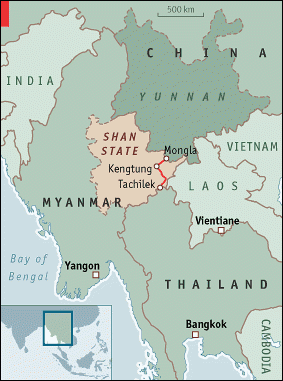Early morning mist hangs over the rice fields and there is a slight chill in the air. We venture out of the town in search of a hot spring encountering groups of women heading off to work. Their chattering and straw hats fade into the distance as they wind their way deeper into the mist. There is an eerie quiet as we search for the spring. Suddenly, it is broken by a laugh and a splash. Peering our heads over the river bank we find two young boys lying in a shallow shored up pool with steam gently rising around them. They are fully clothed and cheekily grin at us, their mouths resting on the waterline. Our search had ended.
Upon leaving that morning we had passed under the enormous government noticeboard dominating the hotel lobby. It divided towns in the northern Shan State into three sections, the majority being in the final two:
- Open for visitation
- Restricted
- Not Permitted
This was followed by the comment: ” All foreigners must remain within the town centres requiring official permission and a guide to leave.” However, lying in the hot spring having ignored these warnings, we let the warm water wash over us and surrendered to the peace and tranquility. We watched the two little boys absorbed in their innocence fashioning make-shift weapons and having breath-holding competitions. Clues to political or social strife were non-existent but at this point we were only 70km from civil war and internal refugee camps.

Map of Myanmar showing Shan State
That afternoon we left the famous literary town Hsipaw (See-paw) heading south on our bicycles. The Shan State is the largest in Myanmar (Burma) lying in the North East, in the foothills of the Himalayas. Hedgerows glisten gold with an absurd number of marigolds whilst gently rolling hills are a patchwork of yellows, whites and shades of pink. Opium fields hide in its patchwork fuelling a seemingly far off decades long civil war.
Our rhythmic pace suddenly slowed as we were caught behind a queue of lorries. We weaved and peered nosily wondering what on earth was going on. Appearing over the hill we found five men dressed in guerrilla uniforms stopped at the roadside. Three were bearing AK47s, one a machine gun and the last rested a metre long loaded rocket launcher on his shoulder. Thoughts of “just look forward” drove my body into automatic as the lorries systematically handed them gifts of water or food. Having been awoken to the realities of the civil war we were glad to only have one more day remaining on this potentially risky stretch.
Luckily that was our only military encounter and in the meantime we had become captivated by the Shan State. Even though the British Foreign Office had deemed the route and certain towns along the Mandalay – Lashio Railway safe to visit, we only saw ten foreign faces in our time there and that was on one day in Hsipaw at sunset point. The kindness of the people was unrivalled. Stopping in restaurants on the side of the road, which were really just converted front rooms of people’s houses, they would be delighted at the opportunity to host foreigners. With no shared language we would make a motion for food and wait for the surprise. It ranged from delicious Shan noodles, rice noodles in a broth with fried vegetables to tasty congee (Chinese porridge) with fried wanton (dumplings). Meals are always accompanied by Chinese tea and sometimes a group of fascinated children eager for a photo opportunity too. Feeling like celebrities, we always obliged.
Between its abundant beauty, cool climate and hospitable people the Shan State stole my heart. However, as I have already mentioned the reality is darker. The state and its people have been subjected to what has been described as the longest ever running civil war, about 60 years. Currently, there are eleven rebel groups in the Shan State alone and it is merely one of several conflict zones in the country. Since independence in 1948 Myanmar has struggled with defining an inclusive nationality as it comprises 135 ethnic groups. Of the population 68% are Barma people with ethnic minorities comprising the remaining 32%. In 1962 there was a military coup consisting of Barma people who believed only the army could hold the country together hence its motto: “one country, one army.” Since then, an estimated 700,000 people have fled Myanmar’s conflict zones to neighbouring countries. However, with the final release of Ann San Su Kyi and establishment of her party, the National League for Democracy there is hope that the problems faced by this multiethnic society will be solved.
-
READ about the Shan Royal City, Hsipaw:
https://www.lonelyplanet.com/myanmar-burma/hsipaw
-
READ about Burma’s Conflicts:
Longest running civil war:
http://edition.cnn.com/2015/11/11/asia/myanmar-shan-rebels-civil-war/
Summary of rebel groups in Myanmar:
http://www.conflictmap.org/conflict/myanmar_rebels
About the Burmese Refugees:
https://refugeesg.wordpress.com/about-the-refugees/
Map of Shan State accredited to: http://myanmartravel.org/shan-state/




